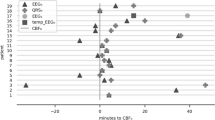Abstract
We studied 12 children (8 female and 4 male) aged 2.2–14.3 years, whose computed tomographic (CT) examination had shown evidence of malacic and/or porencephalic outcomes of early vascular brain infarction. Topographic spectral electroencephalographic (EEG) analysis was performed in all patients in the awake state. The following spectral EEG variables were studied: topography, absolute and relative power of delta, theta, alpha, beta bands, overall power, and peak alpha frequency asymmetries. The results of topographic spectral EEG analysis were compared with the localization and nature of lesions as detected by CT scans. Depending on the nature of the lesions, we were able to identify two different spectral patterns. Porencephalic cysts were characterized by an increase in delta and theta bands in the areas surrounding the lesion sites, as identified by CT. Spectral EEG patterns of malacic outcomes resulted in a focal increase in theta and delta band power, corresponding to the topography of lesions. Moreover, in 9/12 subjects an asymmetry of alpha rhythm in occipital leads was found homolaterally to the lesion sites, associated with a decrease in power, without any CT evidence of an occipital lesion.
Similar content being viewed by others
References
Birchfield RI, Wilson WP, Heyman A (1959) An evaluation of electroencephalography in cerebral infarction and ischemia due to atherosclerosis. Neurology 9:859–871
Buchsbaum MS, Rigal F, Coppola R, Cappelletti J, King AC, Johnson J (1982) A new system for gray-level surface distribution maps of electrical activity. Electroencephalogr Clin Neurophysiol 53:237–242
Damasio H (1983) A computed tomographic guide to the identification of cerebral vascular territories. Arch Neurol 40:138–142
Duffy FH, Bartels PH, Burchfiel JL (1981) Significance probability mapping, an aid in the topographic analysis of brain electrical activity. Electroencephalogr. Clin Neurophysiol 51: 455–462
Faerber EM (1986) Cranial computed tomography in children. Lippincott, Philadelphia
Galletti F, Sturniolo MG (1988) A CT study of vascular outcome patterns in congenital cerebral palsy. Neuropediatrics 19:166–167
Gasser T, Bacher P, Mocks J (1982) Transformations towards the normal distribution of broadband spectral parameters of the EEG. Electroencephalogr Clin Neurophysiol 53:119–124
Homan RW, Herman J, Purdy P (1987) Cerebral location of international 10–20 system electrode placement. Electroencephalogr Clin Neurophysiol 66:376–382
Jonkman EJ, Van Huffelen AC, Pfurtscheller G (1986) Quantitative EEG in cerebral ischemia. In: Lopes da Silva FH, Storm Van Leuwen W, Remond A (eds) Clinical applications of computer analysis of EEG and other neurophysiological signals. (Handbook of electroencephalography and clinical neurophysiology, revised series, vol 2) Elsevier, Amsterdam, pp 205–237
Lehman D (1987) Principles of spatial analysis. In: Gevins AS, Remond A (eds) Methods of analysis of brain electrical and magnetic signals. (Handbook of electroencephalography and clinical neurophysiology, revised series, vol 1) Elsevier, New York, pp 309–349
Lyon G, Evrard P (1987) Neuropédiatrie. Masson, Paris, pp 57–64
Murphy JP, Gervin JS (1947) The electroencephalogram in porencephaly. Arch Neurol Psychiatry 58:436–446
Nagata K, Yunoki K, Araki G, Mizukami M, Hyodo A (1984) Topographic electroencephalographic study of transient ischemic attacks. Electroencephalogr Clin Neurophysiol 58: 291–301
Nagata K, Yunoki K, Araki G, Mizukami M, Hyodo A (1984) Topographic electroencephalographic study of ischemic cerebrovascular disease. In: Pfurtscheller G, Jonkman EJ, Lopes da Silva FH (eds) Brain ischemia, quantitative EEG and imaging techniques. Elsevier, Amsterdam, pp 271–286
Niedermeyer E (1987) The EEG in infantile brain damage and cerebral palsy. In: Niedermeyer E, Lopes da Silva FH (eds) Electroencephalography. Urban & Schwarzenberg, Baltimore München, pp 339–346
Nuwer MR, Jordan SE, Ahn SS (1987) Evaluation of stroke using EEG frequency analysis and topographic mapping. Neurology 37:1153–1159
Pape KE, Wigglesworth JS (1979) Hemorrhage ischemia and the perinatal brain. Heinemann, London
Roseman F, Schmidt RP, Foltz E (1972) Serial electroencephalography in vascular lesions of the brain. Neurology 2:301–331
Sananman ML (1983) EEG vs. computerized tomography of brain in neurological diagnosis. Clin Electroencephalogr 14:116–129
Seri S, Cerquiglini A, Cusmai R, Curatolo P (1991) Tuberous sclerosis: relationships between topographic mapping of EEG, VEPs and MRI findings. Clin Neurophysiol 21:161–172
Steinmetz H, Furst J, Meyer BU (1989) Craniocerebral topography within the international 10–20 system. Electroencephalogr Clin Neurophysiol 72:499–506
Takaesu E, Watanabe K, Inokuma K, Matsumoto A, Sugiura I, Negoro T (1985) EEG topography in porencephalic and arachnoid cysts. Clin Electroencephalogr 16:21–29
Van der Drift JHA, Kok NDK (1972) The EEG in cerebrovascular disorders in relation to pathology. In: Remond A (ed) Cardiac and vascular diseases. (Handbook of electroencephalography and clinical neurophysiology, vol 14) Elsevier, Amsterdam, pp 12–64
Author information
Authors and Affiliations
Rights and permissions
About this article
Cite this article
Cerquiglini, A., Seri, S., Sturniolo, M.G. et al. Computerized electroencephalographic assessment of congenital brain infarction. Child's Nerv Syst 10, 252–258 (1994). https://doi.org/10.1007/BF00301164
Received:
Issue Date:
DOI: https://doi.org/10.1007/BF00301164




